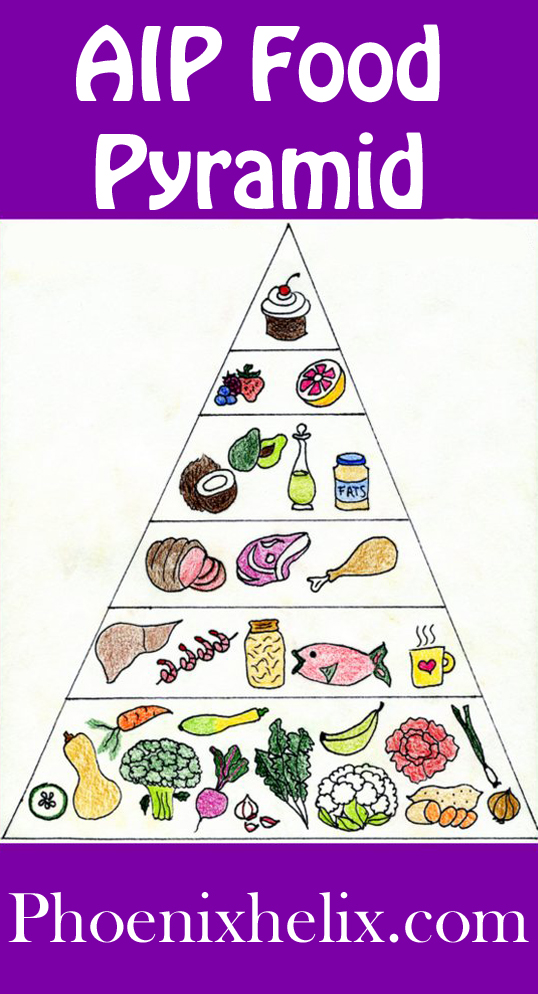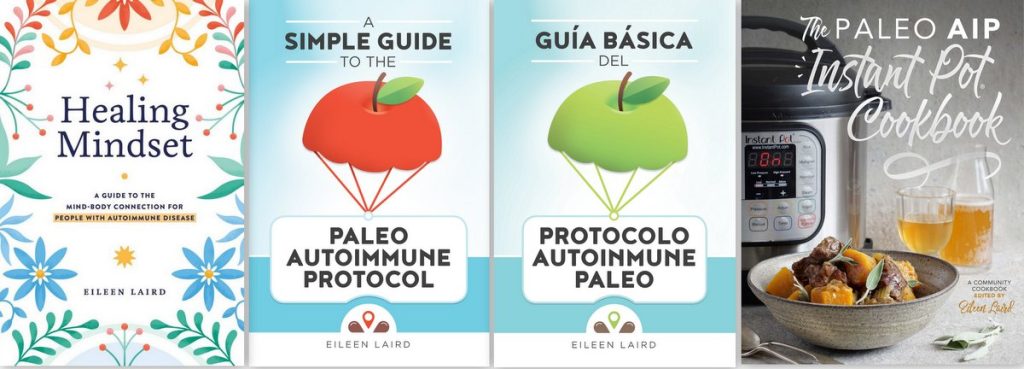
“Acknowledging the good that you already have in your life is the foundation for all abundance.”
~ Eckhart Tolle
Focusing on the Bounty
When we talk about the paleo autoimmune protocol (AIP), we often focus on what we CAN’T eat. There’s a reason for that. It’s a big change from the diet we’ve spent our lives eating, and when you first start the protocol, you can find yourself looking at an empty plate and asking “Well, what CAN I eat?” I have a grocery list on this website, and there are many cookbooks and meal plans available, but sometimes it’s helpful to have a visual picture of what this diet looks like. Here’s the truth: you can eat delicious, satiating food every day on the AIP, and that’s a key to this diet being sustainable. If you feel deprived, you won’t stick with it.
Nutrient Density
Another reason I drew this pyramid (besides the fact that it was fun) is to show which foods should make up the bulk of your diet. In order to reverse autoimmune disease, you need to give your body intense nutrition to heal. If all you’re doing is eating chicken breasts and AIP desserts, you’re unlikely to be successful. This is a common mistake people make on the AIP. The foundation of the AIP food pyramid is healing foods, and we need to become nutrient seekers.
Pyramid Layers
- The Base/Foundation: 6-14 Cups Vegetables Per Day (Measured Before Cooking). That seems like a lot, doesn’t it? There’s a reason. Dr. Terry Wahls is the physician who reversed MS and got out of a wheelchair and onto a bicycle, through a nutrient-dense paleo diet. A key to her healing was getting nutrition through food instead of supplements, and her research showed that vegetables contain 31 micronutrients that our bodies need to heal. Dr. Sarah Ballantyne was inspired by Terry’s research when she wrote The Paleo Approach. Sarah’s health also started to turn around when she focused on nutrient density. So, eat as wide a variety of vegetables as possible, from the following food groups: brightly colored, leafy greens, and sulfur-rich. Also eat a little bit of seaweed every week. The only vegetables not allowed on the AIP are nightshades and legumes. The vegetables are measured raw, but strive to eat a combination of cooked and raw vegetables for optimal nutrition. However, if you have digestive issues, cooked vegetables are easier to digest. Want some recipe inspiration? Here’s an A-Z Vegetable Recipe Roundup.
- Level 2: Organ Meats, Wild-Caught Seafood, Bone Broth and Fermented Foods. These are all important healing foods on the AIP. Organ meats have 10-100 times the nutrition of other cuts of meat. It’s a myth that they store toxins. Rather, they store the nutrition our bodies need to remove toxins. Ideally, eat them at least 4 times per week. Wild-caught seafood is the most abundant source of omega-3 fatty acids. A key to reducing inflammation in the body is increasing omega-3 consumption and decreasing omega-6 consumption. Ideally, eat seafood at least 3 times per week. Bone broth contains nutrition that helps heal a leaky gut, and there is a direct connection between leaky gut and autoimmune disease. Ideally, drink 1 cup daily. Fermented foods are beneficial in many ways: they help moderate the immune system, heal leaky gut, aid digestion, and act as anti-inflammatories. Eat some every day.
- Level 3: Quality Meats. The AIP isn’t a vegetarian diet. Meat is rich in bio-available vitamins and minerals that we can’t find elsewhere, particularly B vitamins, iron and zinc. And if your meat is grass-fed, it also has omega-3 fatty acids, CLA and Vitamin K2. I know not everyone can afford grass-fed meat all the time. Work within your budget, and do the best you can. Some of the least expensive cuts are organ meats, bones, ground meat, and braising meats (the tougher cuts that become tender with longer cooking times).
- Level 4: Healthy Fats. Many of us were raised in a low-fat culture, so it can be shocking to realize that fats are essential to our health. 50% of every cell membrane is made of fat, and 60% of our brain is fat. Fats are the building blocks of our hormones, and many vitamins are fat-soluble, meaning we can’t absorb them without fat. So, incorporate autoimmune-friendly fats into every meal: coconut oil, lard, tallow, duck fat, red palm oil, extra virgin olive oil and avocado oil.
- Level 5: Fruit. When you stop eating junk food, fruit suddenly tastes so much sweeter. An added bonus is that it’s nutritious at the same time. Berries are an especially good choice, since they are higher in antioxidants than other fruits. Since fruits contain natural sugars, limit to a few servings per day on the AIP. Goji berries are the only fruit excluded on the AIP, because it’s a nightshade.
- Level 6: Treats. Part of being happy on the AIP long-term is knowing you can have cake on your birthday, and the occasional cookie or slice of pie. If you feel too deprived, you’ll be tempted to binge on commercial junk food, and that’s a recipe for a flare. Just remember this is the smallest level on the food pyramid. Save treats for special occasions, and savor every bite.
- Recipes: I have a large AIP recipe collection on this website. There are also over 40 AIP cookbooks available!
- Note: This food pyramid is based on the AIP as described in The Paleo Approach. And if you’re looking for recipes,
The Politics of the USDA Food Pyramid
Did you know that the woman hired to research and create the FDA food pyramid didn’t include grains as the foundation? Instead, she recommend vegetables as the foundation, then meat, then healthy fats. She limited “empty calories” to 10% of daily intake, and included most grains in that category. When she submitted it to her supervisors, food lobbyists took over, and literally turned her food pyramid upside down. She warned that if they published those recommendations, obesity and chronic disease would skyrocket. And that’s exactly what happened. For the full story, read the compelling book, Death By Food Pyramid.
You May Also Be Interested In










Hi Eileen,
I am a primal diet eater(almost equal API).I proceed ultra low-carbon diet for almost one month(no fruit,no vegetables..).Suddenly i ate 400g sweet potato and some avocados the day before the yesterday,but then recently these two days I have l little bit red on my cheek and I got Gastroesophageal reflux symptoms:no matter a little bit of kelp or plenty of mutton,all of them i can’t be easy to digest and I want to vomit food after I ate up . I am wondering if there are some problems with my immune systems and if detox program can relieve these symptoms?
Thanks,
Ning
Ning, it’s more likely the dramatic transition between those 2 diets. First let me say that I don’t recommend a diet with no fruits or vegetables. That’s a nutrient-deficient diet that will cause health problems rather than help. If you want to try a ketogenic diet, this podcast explains how to do it safely and nutritiously. Second, it’s best to transition slowly in and out of ketosis. That allows your digestion time to acclimate. (Note to other readers: the AIP isn’t a ketogenic diet.) If you have trouble digesting vegetables overall, you might need digestive support in the form of enzymes or other assistance. There are also some tips shared in this podcast: Paleo Dietitian Q&A. And if you would like 1:1 help, I recommend hiring an AIP Certified Coach. Wishing you wellness!
Hi Eileen,
I’m wondering if I’m eating too much meat/protein – I’ve been following the AIP for over a year now (as well as your blog!), and I have meat or fish at every breakfast, lunch and dinner. This seems to have worked for me over the last year, but I’m wondering if I should consider that more of a short-term intervention. Both for the sake of my long-term health and of my budget! Do we need to eat protein at every meal?
Thanks,
Paul
Hi Paul. Protein is really essential to health. I eat it at every meal as well. Nutritionist Diana Rodgers delved into this issue in her article: More Protein, Better Protein. Her concern is that people often don’t eat enough. As long as you are also eating large quantities of vegetables (the base of the AIP food pyramid), that’s a diet that optimizes your health. For budget tips, tune into my latest podcast episode: Sticking To It – Staying On the AIP Wagon. Stacy gives lots of great advice at timestamp 56:27.
Thanks for the quick reply Eileen!
I have dry eyes and stomach issues, so I want to try aip protocol for 30 days to see if I see any improvement. I have been gluten, dairy, soy and sugar free for many years, but I still have a lot of problems. Why is stevia not allowed? I don’t consume a lot of stevia, just two times a week when I eat my cranberries. also after I do my detox, can I introduce back the stevia and coffee. I don’t drink a lot of coffee, just two cups for week, but I think this is the only thing I am going to miss. Not eating grains, beans, or soy is not a problem for me, I have not desire for them. So If I have to eliminate them for ever, I don’t care. I don’t know if this is going to help me, but I will not know until I try it. also, are tiger nuts, and milk in moderation allowed?
Hi Cathy. Here’s an article that explains why stevia isn’t allowed: https://www.thepaleomom.com/teaser-excerpt-from-the-paleo-approach-the-trouble-with-stevia/. During the reintroduction phase, you can definitely try reintroducing coffee and see how your body reacts. Tigernuts and tigermilk in moderation are absolutely fine. If you have further questions, I recommend my book: A Simple Guide to The Paleo Autoimmune Protocol, which will tell you everything you need to know. Welcome to the AIP community!
Thank you for this great post and all the other tremendous work you do, you are constant companion of mine on this MS journey. Also thank you to all the other great female contributors for AIP, men can be so sulky and silent 🙂
Well, you don’t sound sulky and silent. 😉 Thanks so much for your kind words, Andrew. I’m honored to be part of your journey.
Thank you so much for the food pyramid. That helps so much!
You’re welcome! I included it in my upcoming book as well. It helps to see a visual.
My 5 year old and I just did one of this (home school) science lessons this morning. The text book went over the traditional food pyramid and what constitutes “healthy” meals. Thankfully we were able to talk about how some of those foods can really hurt our bodies instead. I’m printing your pyramid now so that we can compare and talk about which foods make us feel better. 🙂
The beauty of home schooling! I love that you used this food pyramid for a lesson. Thanks for letting me know.
Beautiful job on this pyramid, Eileen! Even if one is not following AIP (I’m not … yet anyway), this is a great plan to follow and I love your art work! 🙂 Shared on Facebook and pinned.
Thanks!
Shirley
Thanks, Shirley! I had fun drawing it. 🙂
I see it’s already been mentioned, but I also would gladly buy this in a print and/or poster! What a fun and useful piece of art it would be to display in our kitchens.
Superb post, Eileen!
Thanks, Martine!
Thank you for this super helpful visual, Eileen! Are the 8-14 cups of veggies measured raw or cooked?
Great question! They’re measured raw, and I’ve edited the article to make that more clear. For the best nutrition, eat a variety of raw and cooked vegetables for optimal nutrition.
AIP or not…this a brilliant visual for how we should ALL strive to eat! I have some interesting conversations with my kiddos when they come home from school after their ‘nutrition’ units….they think they need to eating a ton of cheese and milk to be healthy, among other things! Featuring your info-graphic this week!
Thanks, Tessa! Those ‘nutrition’ units must drive you crazy. I’m hoping someday, real nutrition advice will make it into the mainstream.
This is such a great post! I was actually hoping that someone would write an article like this. 🙂
Thanks, Fiona!
Great post, and I wrote about it in my own post today at felicialibo.com to share it with others. You have been so helpful to me with my recent diagnosis of psoriatic arthritis and the AIP lifestyle, and I hope to someday be one of your “success stories.” Thanks again.
Thanks for sharing, Felicia!
Thanks for posting this.
My pleasure.
Fantastic post! Your pyramid says it all. I just forwarded this to five others including a “newbie”. When I get questions about what I eat and why – and that is frequently – I am sending this post! Thank you from a loyal follower.
Thanks, Terri. That’s wonderful!
Thank you for the foodpyramid! I would gladly buy a poster with these motives.
That’s an interesting idea! I’ll let you know if I ever produce one, Birgitta.
This is such a great post Eileen. The visual really helps me stay on my game. Yours is my go to site whenever I get stuck in the “too much information” maze of healing. I bless you for this regularly! Thank you!
Regarding my previous comment, that is to say, Phoenix Helix: Here lies clarity.
Very grateful!
Thanks so much, Cindy. To me, there’s no higher compliment.
Thank you for such a great post. I struggle getting in as many veggies as I’d like. Lots of great inspiration in here, and a couple I’m scheduling into my weekly meal plan!
Awesome Christine!
Eileen, this is an excellent and very encouraging post! Sometimes I am just eating meat and legal treats, so you were talking right to me there. This pyramid is GREAT.
Lina, I love your honesty, and that is exactly why I wrote this post!
What a great post! It’s a shame what the government has done to us, all in the name of money. Sharing 🙂
Thanks for sharing, April!